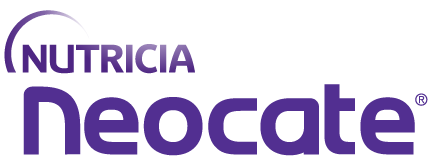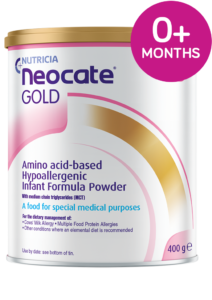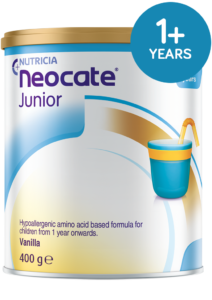Growing up with cows’ milk protein allergy from 0-12 months
Key takeaways
- Cows’ milk protein allergy (CMPA) is common with one in every five babies diagnosed in Australia, most will outgrow it at age 3-5 years1,2
- Management of CMPA involves the elimination of cows’ milk protein from the diet
- Elimination from the diet may involve elimination of cows’ milk protein for mothers who are breastfeeding
- If formula fed, infants may require a specialised infant formula to manage CMPA
- Introducing solids is an important part of development and will happen at around 6 months and not before 4 months
- When introducing solids, caution should be taken with foods with cows’ milk protein in infants with confirmed CMPA. Discuss with your healthcare professional on how best to introduce other allergenic foods.

Cows’ milk protein allergy (CMPA) is common in infants in Australia and New Zealand. Approximately one in every fifty babies will be diagnosed with this condition.1 Both breastfed and formula-fed infants can develop CMPA. Fortunately, most children will outgrow the allergy by their third or fourth birthday.2
Once your child has been diagnosed with CMPA by a doctor, there will be some changes required to help manage the condition. Treatment involves the removal of all foods containing cows’ milk from your child’s diet, or in some cases, from the diet of the breastfeeding mother. With the help of your healthcare professional and appropriate dietary management solutions e.g., allergy specific formulas where indicated, the challenges of CMPA can be easily navigated through the first year and beyond.
From birth to six months
Most infants will receive either breast milk and/or infant formula as their sole source of nutrition for around the first six months of life. Breast milk is the best nutrition for your infant and if possible, breastfeeding should be continued after diagnosis of CMPA.2 The steps needed to manage CMPA for both breast-fed and formula-fed infants are listed below:
Breast-fed Infants
Cows’ milk protein allergy is less common in exclusively breast-fed infants, however, a CMPA can still occur.2 Sensitive babies will react to cows’ milk protein, eaten in the mother’s diet, being passed through the breast milk.3 If an exclusively breast-fed infant is diagnosed with CMPA then the mother may need to remove cows’ milk protein from her diet.1 It is important to check with your healthcare professional before making any diet changes.
If elimination of cows’ milk protein from the mother’s diet is required, it is important to ensure that alternative non-dairy sources of calcium are included. The mother’s diet not only affects her health, but also the quality of her breast milk.4 Your healthcare professional will be able to provide advice regarding non-dairy substitutes and there are also some ideas provided in the allergy-friendly shopping list section on this website.
Formula-fed Infants
Formula-fed infants diagnosed with CMPA will need to be changed to an alternative cows’ milk-free formula. Standard infant formulas are made by modifying cows’ milk-based formulas to meet the nutritional requirements of infants. These formulas will trigger symptoms in a baby with CMPA. For infants under six months of age with CMPA, substitute formulas may include an extensively hydrolysed formula (eHF) or an amino acid-based formula (AAF). These formulas should be recommended by your child’s doctor.
Extensively hydrolysed formulas are made from cows’ milk that has been treated with enzymes to break down the proteins that cause cows’ milk protein allergy so that they are less likely to trigger an allergic reaction.1 Extensively hydrolysed formulas are usually the first choice to treat mild-to moderate cows’ milk protein allergy for children under six months of age. A small number of children, however, will not tolerate or have symptom improvement while on eHFs. For these children, and those with severe allergic reactions, AAFs are usually recommended. Amino acid-based formulas are made from amino acids, which are the building blocks of protein. They contain no cows’ milk protein and should be tolerated by almost all infants with CMPA.1
From six to twelve months of age
As your infant grows, they will start to need more nutrition than breast milk and/or infant formula alone can provide.5 When your baby is developmentally ready, usually at around six months of age (but not before four months), solid foods can start to be introduced in addition to breast milk and/or infant formula.4 This is an exciting milestone for parents but can also cause a lot of anxiety for parents of a child with CMPA. Thankfully, there is lots of support and information available to help you through this time.
Introducing solid foods is a crucial step in your child’s development. It will help your little one learn the motor skills needed for chewing, biting and swallowing.5 A child’s early experiences with food will also help to shape their eating behaviours later in life.5
To help develop these skills, infants should be exposed to a wide range of flavours and textures. The textures that are suitable for your child will progress as they develop.5 Generally, children start with pureed foods and then move onto mashed and chopped foods. From around 8 months of age, most children should be able to manage finger foods. By the time your baby reaches twelve months they should be eating with the rest of the family.
The first foods that are introduced should contain iron, like pureed meat, fish or fortified baby cereal. After this, foods should be introduced according to what your family usually eats. Australian allergy guidelines advise that there is no need to delay the introduction of other foods that commonly cause allergies, like eggs, soy, nuts, fish and wheat.4 It is, however, advised that new foods are introduced with a gap of two to three days to allow for easy identification if a reaction does occur.4
Children with confirmed cows’ milk protein allergy will need to avoid all foods containing cows’ milk protein. This includes cows’ milk and all dairy products, such as yoghurt, cheese, butter and cream. Parents will also need to check the labels of all manufactured foods to make sure the food does not contain cows’ milk protein. To ensure your child receives the nutrients usually provided in cows’ milk, it is important to include calcium-containing non-dairy substitutes.
Throughout the first year of life, breast milk and/or an allergy specific infant formula should be the main drink for your child.5 For formula-fed infants diagnosed with cows’ milk protein allergy after six months of age, they may be started on soy-based infant formula, rather than an AAF or eHF, consultation with your child’s healthcare professional is recommended.3
As infants grow their nutritional needs change and this can be challenging when a child has an allergy, however with the right support and some creativity you will be able to introduce a world of food options to support their growth.
This article is not intended to be a substitute for medical advice. Always consult your doctor.
References accessed 29th July 2021
- Australasian Society of Clinical Immunology and Allergy (ASCIA). Cows’ milk (dairy) allergy 2019. Available from: http://www.allergy.org.au/patients/food-allergy/cows-milk-dairy-allergy (Accessed July 2021)
- Motala & Fiocchi. 2012. Cow’s Milk Allergy in Children. World Allergy Organisation. Available from: http://www.worldallergy.org/professional/allergic_diseases_center/cows_milk_allergy_in_children/ (Accessed July 2021)
- Vandenplas Y, et al. Guidelines for the diagnosis and management of cows’ milk protein allergy in infants. Arch Dis Child. 2007;92:902-908.
- Australasian Society of Clinical Immunology and Allergy (ASCIA). Food Allergy – Frequently Asked Questions 2021. Available from: https://www.allergy.org.au/patients/food-allergy/faqs (Accessed July 2021)
- National Health and Medical Research Council (NHMRC). 2012. Infant feeding guidelines: Information for health workers. Available from: https://www.nhmrc.gov.au/guidelines-publications/n56 (Accessed July 2021)






